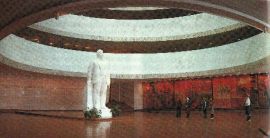Lenin before and during the WWI by the Kiev Branch of the Central Lenin Museum in Soviet Ukraine
 A whole range of items is devoted to the preparation and the work of the 2nd RSDLP Congress in 1903, at which the process of uniting the revolutionary Marxist organisations was completed and a party of Russia’s working class founded on the ideological, political and structural principles developed by Lenin.
A whole range of items is devoted to the preparation and the work of the 2nd RSDLP Congress in 1903, at which the process of uniting the revolutionary Marxist organisations was completed and a party of Russia’s working class founded on the ideological, political and structural principles developed by Lenin.
Here there are also photographs of Lenin’s closest associates, reproductions of pages from the draft of the Party Program, photo-copies of Lenin’s congress diary, and manuscripts of his speeches (in all, over 130 speeches and remarks). At the congress, a split occurred in the party: the members of the revolutionary majority with Lenin in the lead were known as the Bolsheviks from then on, and the supporters of the opportunistic minority — the Mensheviks.
In this section are materials on the Ulyanovs’ stay in Kiev in 1903 and 1904 (Lenin’s mother, two sisters, and brother) and on their revolutionary activity (in Kiev there is the Ulyanov Memorial Apartment-Museum descri¬bed in the guide).
A large section consists of exhibits reflecting Lenin’s activity during Russia’s first bourgeois-democratic revolution of 1905-1907. It flared up in the wake of the events of January 9, 1905 in St. Petersburg, when a peaceful demonstration of workers was fired upon by tsarist troops. This action triggered off a wave of popular revolts throughout the country.
While still in emigration, Lenin carried on work to convene the 3rd RSDLP Congress which met in London in April 1905 and considered the strategy and tactics of proletarian struggle under conditions of mounting revolution. Some of the highlights of the revolution are shown in photographs, documents, and paintings: the armed uprising in Moscow in December 1905, the peasant unrest in the Ukraine, and the mutiny on the battleship Potemkin.
The experience gained in this struggle, along with the results of the 3rd RSDLP Congress, became the underlying material for Lenin’s book Two Tactics of Social-Democracy in the Democratic Revolution (1905), in which he worked out the theory of a bourgeois-democratic revolution developing into a socialist revolution. The museum displays the first Geneva edition of this book.
In November 1905, at the height of the revolutionary events, Lenin entered Russia illegally. The museum exhibits one of the first issues of the legally published Bolshevik newspaper Novaya Zhizn (New Life) under Lenin’s editorship and a photo-copy of his article «Party Organisation and Party Literature», which appealed to the democratic intellectuals. A number of materials tell about the revolutionary developments in the Ukraine and the uprising of the sappers in Kiev under the leadership of Second Lieutenant Boris Zhadanovsky.
The next section traces the activities of Lenin and the Bolshevik Party during the period of reaction that followed the defeat of the revolution, when the tsarist regime subjected the working class and its vanguard to repressive measures. By decision of the Bolshevik centre, Lenin was to emigrate abroad; this time he lived outside Russia for ten years. But during these years, he led the effort to preserve and consolidate the party.
In Geneva, he resumed the publication of the Bolshevik newspaper Proletary (Proletarian) and finished working on his book Materialism and Empirio-Criticism (1909) which marked a new stage in the development of Marxist philosophy.
This period in Lenin’s activity is reflected in the photographs of the houses in Geneva and Paris where he lived and in a model of the reading room at London’s British Museum where he did a great deal of his work.
Between 1910 and 1914, Russia lived through a new wave of revolutionary upsurge incited by the shooting of striking workers at the Siberian gold fields on the Lena River in 1912. On display there are photo documents, issues of the Bolshevik daily newspaper Pravda published legally since 1912 under the guidance of its founder Lenin, and photographs of the members of its editorial board and most active contributors.
The day its first issue was published — April 22 (May 5), 1914 — became a holiday of the workers’ press, and since 1922, May 5 has been marked as Press Day in the Soviet Union. The exhibits acquaint the visitor with Lenin’s work on convening the 4th All-Russia Conference of the RSDLP in Paris in 1912. The congress expelled the opportunists from the Party’s ranks and set its objectives for the period of a new mighty revolutionary upsurge in Russia.
Further on, the exhibition deals with Lenin’s activity during the First World War which started in 1914. From the very outset, Lenin defined the war as predatory, unjust and aggressive. On display in this section are documentary photos and an October 1914 issue of the newspaper Sotsial-demokrat (Social-Democrat), then the central organ of the Party, with the manifesto The War and Russia’s Social-Democracy, in which Lenin emphasised that the defeat of tsarist Russia in the war would make it easier for the country’s proletariat to win the victory over tsarism. In a number of his writings, Lenin advocated the international unity of the proletariat.
Lenin’s international ties are charted out on a map accompanied by photographs of outstanding personalities in the international workers’ and communist movement which include Karl Liebknecht, Rosa Luxemburg, Clara Zetkin, Dimitr Blagoyev, Georgi Dimitrov, and Antonio Gramsci. The first (September 1917) edition of Lenin’s fundamental work, Imperialism, the Highest Stage of Capitalism, which he wrote in 1916, making him the first Marxist to describe the economic and political essence of imperialism, is to be found in this section.
